instrument cluster Mercury Grand Marquis 2006 s Owner's Guide
[x] Cancel search | Manufacturer: MERCURY, Model Year: 2006, Model line: Grand Marquis, Model: Mercury Grand Marquis 2006Pages: 272, PDF Size: 2.47 MB
Page 182 of 272
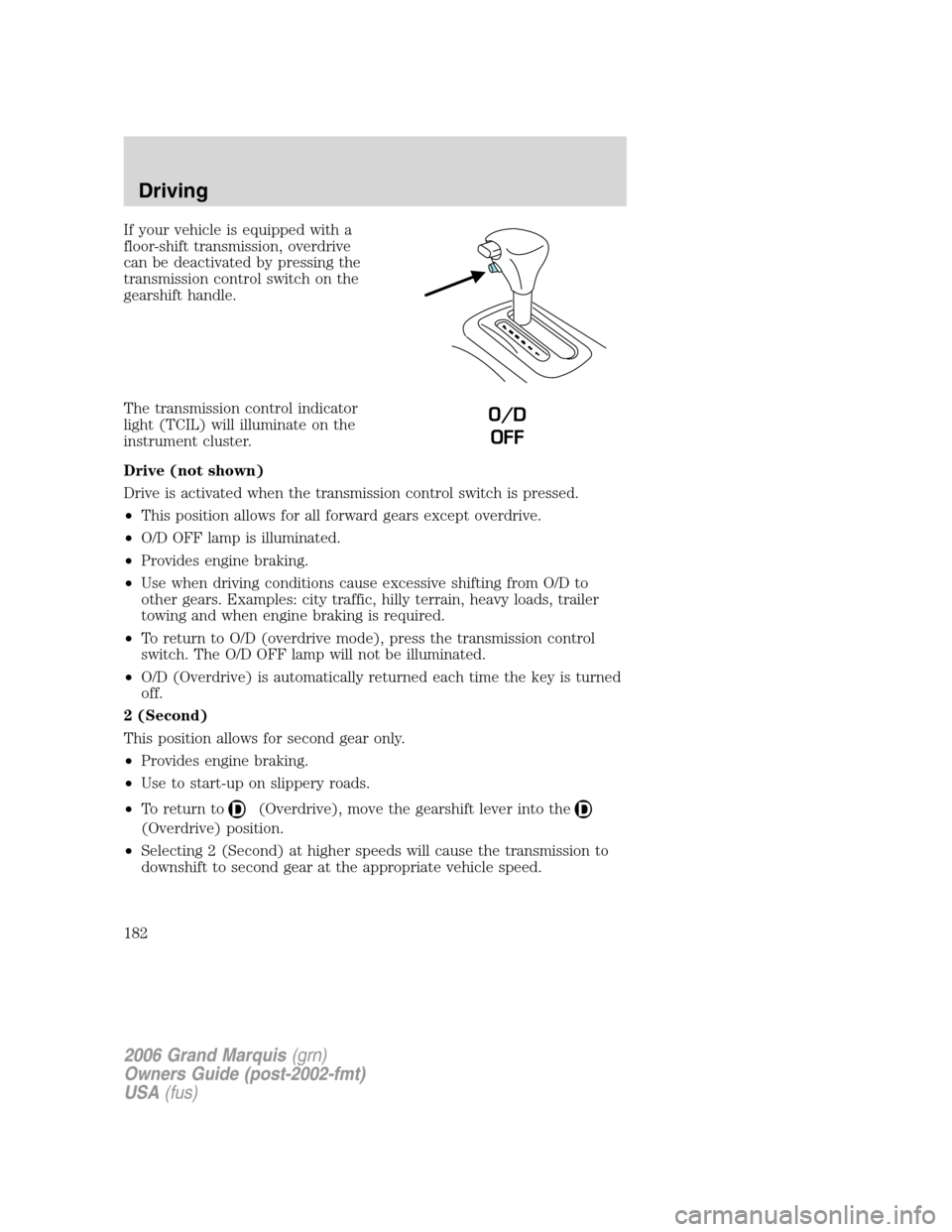
If your vehicle is equipped with a
floor-shift transmission, overdrive
can be deactivated by pressing the
transmission control switch on the
gearshift handle.
The transmission control indicator
light (TCIL) will illuminate on the
instrument cluster.
Drive (not shown)
Drive is activated when the transmission control switch is pressed.
•This position allows for all forward gears except overdrive.
•O/D OFF lamp is illuminated.
•Provides engine braking.
•Use when driving conditions cause excessive shifting from O/D to
other gears. Examples: city traffic, hilly terrain, heavy loads, trailer
towing and when engine braking is required.
•To return to O/D (overdrive mode), press the transmission control
switch. The O/D OFF lamp will not be illuminated.
•O/D (Overdrive) is automatically returned each time the key is turned
off.
2 (Second)
This position allows for second gear only.
•Provides engine braking.
•Use to start-up on slippery roads.
•To return to
(Overdrive), move the gearshift lever into the
(Overdrive) position.
•Selecting 2 (Second) at higher speeds will cause the transmission to
downshift to second gear at the appropriate vehicle speed.
O/D
OFF
2006 Grand Marquis(grn)
Owners Guide (post-2002-fmt)
USA(fus)
Driving
182
Page 217 of 272
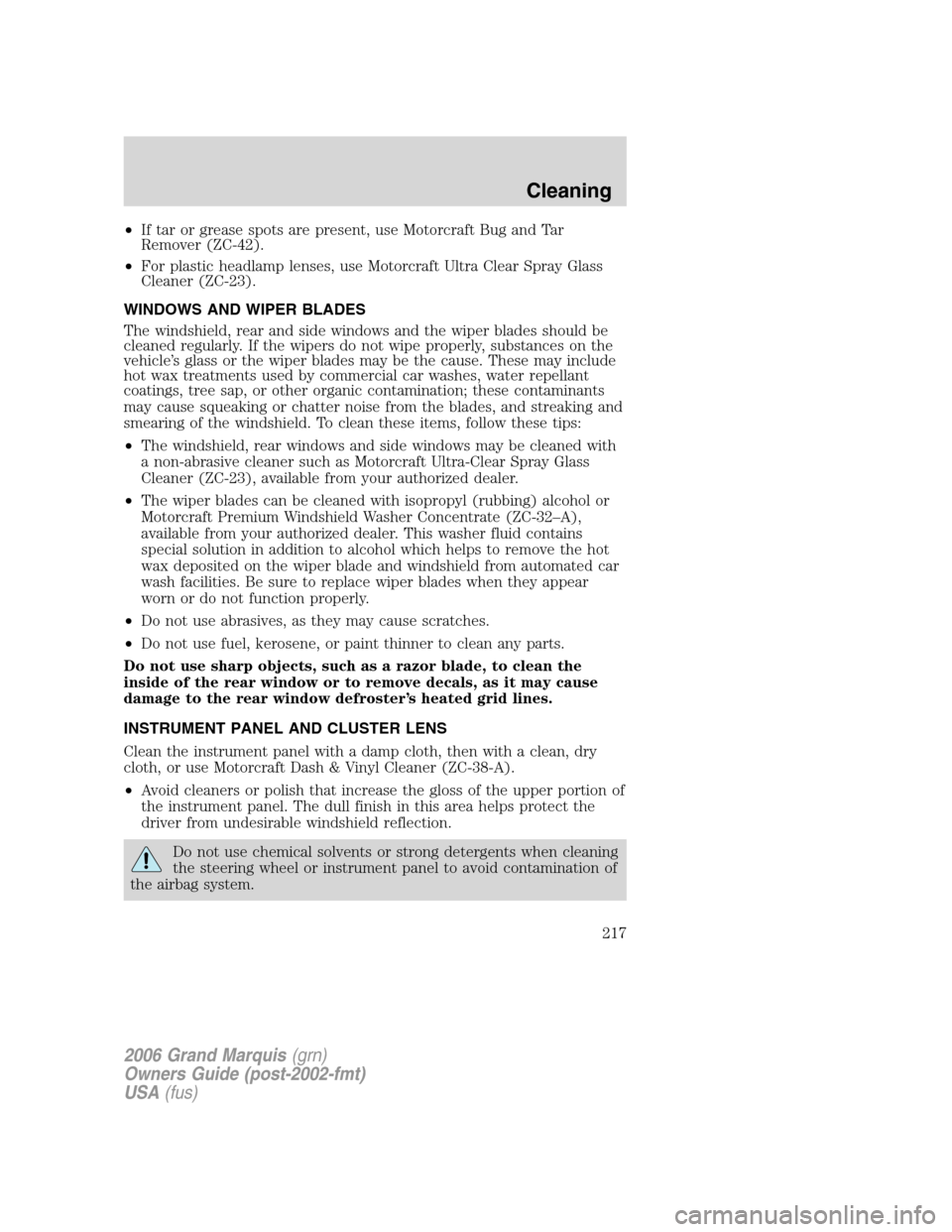
•If tar or grease spots are present, use Motorcraft Bug and Tar
Remover (ZC-42).
•For plastic headlamp lenses, use Motorcraft Ultra Clear Spray Glass
Cleaner (ZC-23).
WINDOWS AND WIPER BLADES
The windshield, rear and side windows and the wiper blades should be
cleaned regularly. If the wipers do not wipe properly, substances on the
vehicle’s glass or the wiper blades may be the cause. These may include
hot wax treatments used by commercial car washes, water repellant
coatings, tree sap, or other organic contamination; these contaminants
may cause squeaking or chatter noise from the blades, and streaking and
smearing of the windshield. To clean these items, follow these tips:
•The windshield, rear windows and side windows may be cleaned with
a non-abrasive cleaner such as Motorcraft Ultra-Clear Spray Glass
Cleaner (ZC-23), available from your authorized dealer.
•The wiper blades can be cleaned with isopropyl (rubbing) alcohol or
Motorcraft Premium Windshield Washer Concentrate (ZC-32–A),
available from your authorized dealer. This washer fluid contains
special solution in addition to alcohol which helps to remove the hot
wax deposited on the wiper blade and windshield from automated car
wash facilities. Be sure to replace wiper blades when they appear
worn or do not function properly.
•Do not use abrasives, as they may cause scratches.
•Do not use fuel, kerosene, or paint thinner to clean any parts.
Do not use sharp objects, such as a razor blade, to clean the
inside of the rear window or to remove decals, as it may cause
damage to the rear window defroster’s heated grid lines.
INSTRUMENT PANEL AND CLUSTER LENS
Clean the instrument panel with a damp cloth, then with a clean, dry
cloth, or use Motorcraft Dash & Vinyl Cleaner (ZC-38-A).
•Avoid cleaners or polish that increase the gloss of the upper portion of
the instrument panel. The dull finish in this area helps protect the
driver from undesirable windshield reflection.
Do not use chemical solvents or strong detergents when cleaning
the steering wheel or instrument panel to avoid contamination of
the airbag system.
2006 Grand Marquis(grn)
Owners Guide (post-2002-fmt)
USA(fus)
Cleaning
217
Page 241 of 272
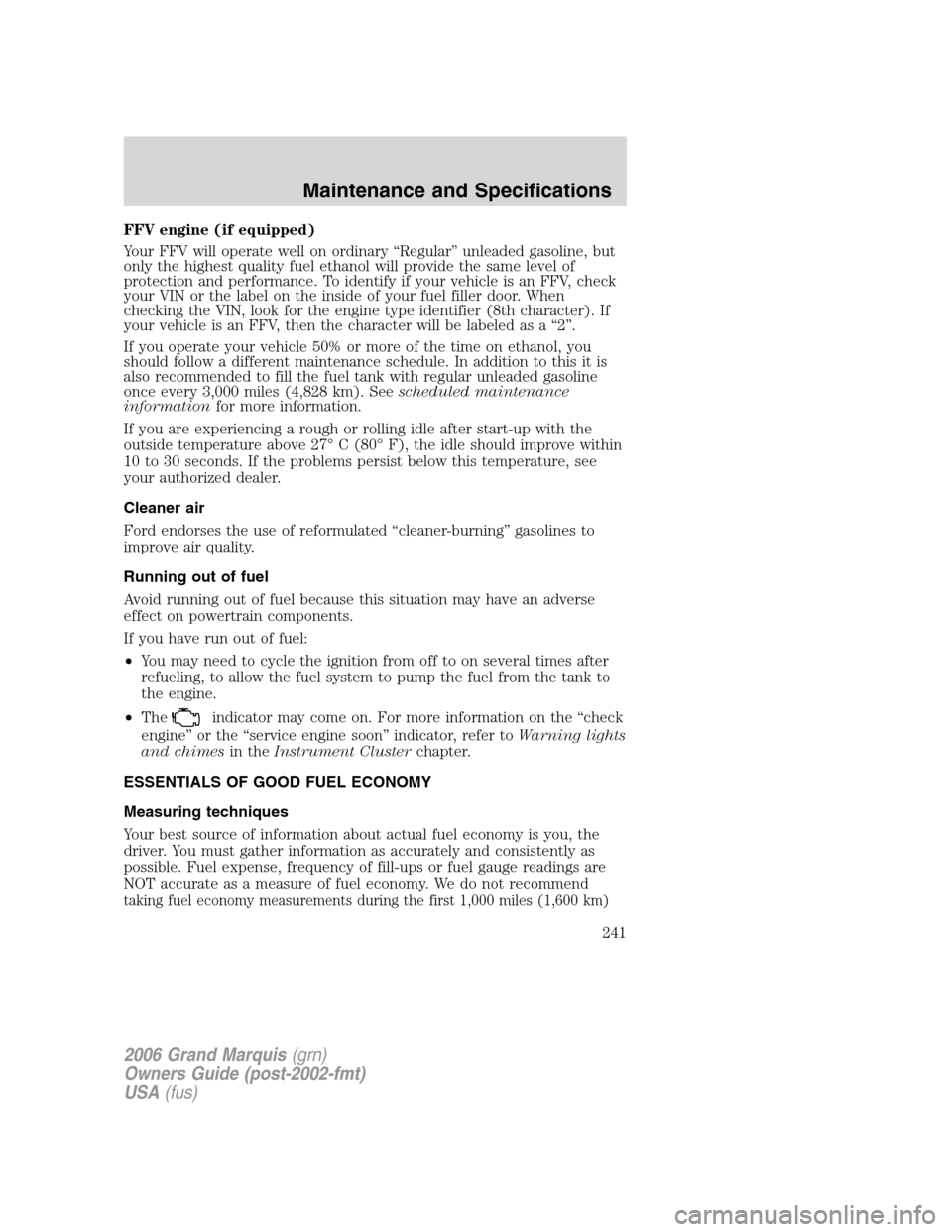
FFV engine (if equipped)
Your FFV will operate well on ordinary “Regular” unleaded gasoline, but
only the highest quality fuel ethanol will provide the same level of
protection and performance. To identify if your vehicle is an FFV, check
your VIN or the label on the inside of your fuel filler door. When
checking the VIN, look for the engine type identifier (8th character). If
your vehicle is an FFV, then the character will be labeled as a “2”.
If you operate your vehicle 50% or more of the time on ethanol, you
should follow a different maintenance schedule. In addition to this it is
also recommended to fill the fuel tank with regular unleaded gasoline
once every 3,000 miles (4,828 km). Seescheduled maintenance
informationfor more information.
If you are experiencing a rough or rolling idle after start-up with the
outside temperature above 27° C (80° F), the idle should improve within
10 to 30 seconds. If the problems persist below this temperature, see
your authorized dealer.
Cleaner air
Ford endorses the use of reformulated “cleaner-burning” gasolines to
improve air quality.
Running out of fuel
Avoid running out of fuel because this situation may have an adverse
effect on powertrain components.
If you have run out of fuel:
•You may need to cycle the ignition from off to on several times after
refueling, to allow the fuel system to pump the fuel from the tank to
the engine.
•The
indicator may come on. For more information on the “check
engine” or the “service engine soon” indicator, refer toWarning lights
and chimesin theInstrument Clusterchapter.
ESSENTIALS OF GOOD FUEL ECONOMY
Measuring techniques
Your best source of information about actual fuel economy is you, the
driver. You must gather information as accurately and consistently as
possible. Fuel expense, frequency of fill-ups or fuel gauge readings are
NOT accurate as a measure of fuel economy. We do not recommend
taking fuel economy measurements during the first 1,000 miles (1,600 km)
2006 Grand Marquis(grn)
Owners Guide (post-2002-fmt)
USA(fus)
Maintenance and Specifications
241
Page 246 of 272
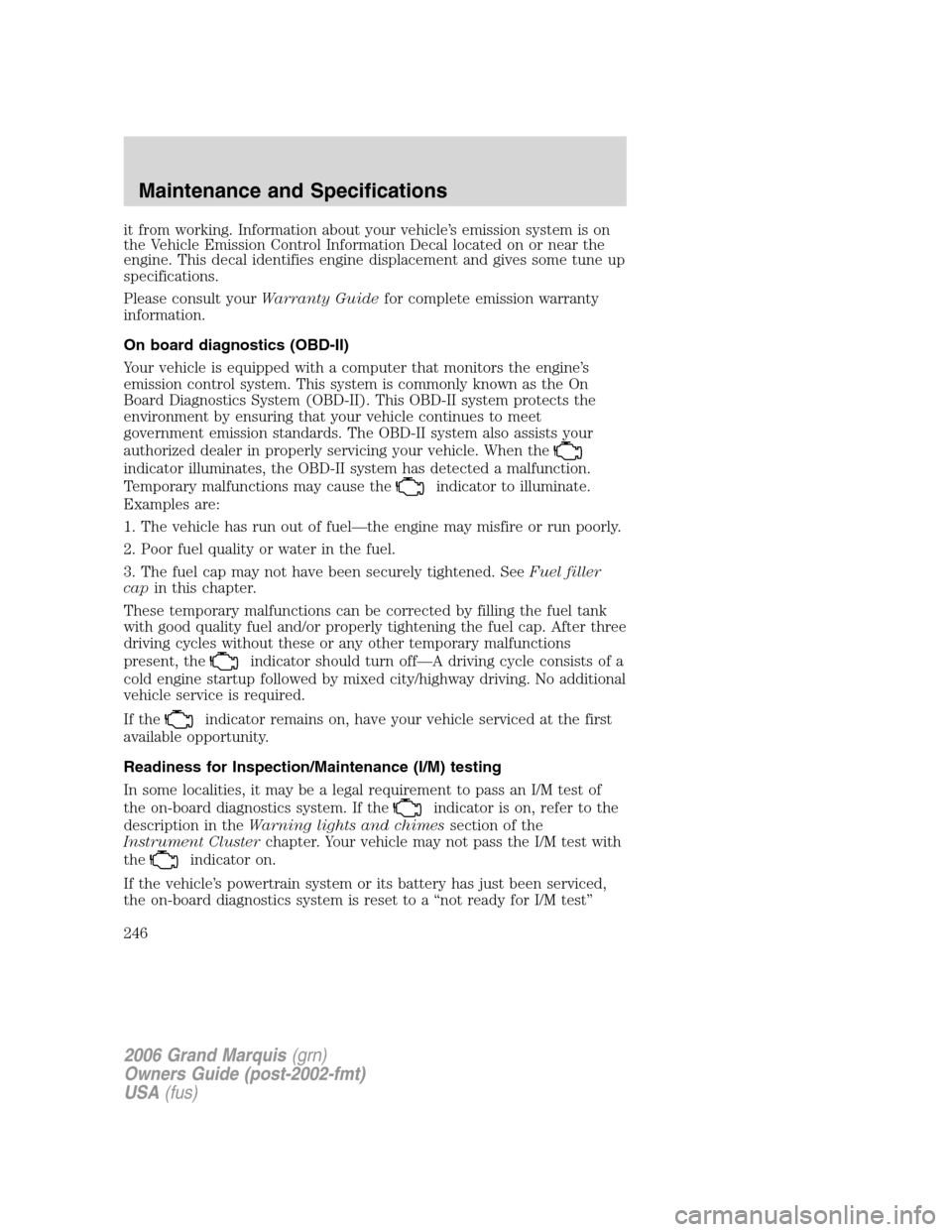
it from working. Information about your vehicle’s emission system is on
the Vehicle Emission Control Information Decal located on or near the
engine. This decal identifies engine displacement and gives some tune up
specifications.
Please consult yourWarranty Guidefor complete emission warranty
information.
On board diagnostics (OBD-II)
Your vehicle is equipped with a computer that monitors the engine’s
emission control system. This system is commonly known as the On
Board Diagnostics System (OBD-II). This OBD-II system protects the
environment by ensuring that your vehicle continues to meet
government emission standards. The OBD-II system also assists your
authorized dealer in properly servicing your vehicle. When the
indicator illuminates, the OBD-II system has detected a malfunction.
Temporary malfunctions may cause the
indicator to illuminate.
Examples are:
1. The vehicle has run out of fuel—the engine may misfire or run poorly.
2. Poor fuel quality or water in the fuel.
3. The fuel cap may not have been securely tightened. SeeFuel filler
capin this chapter.
These temporary malfunctions can be corrected by filling the fuel tank
with good quality fuel and/or properly tightening the fuel cap. After three
driving cycles without these or any other temporary malfunctions
present, the
indicator should turn off—A driving cycle consists of a
cold engine startup followed by mixed city/highway driving. No additional
vehicle service is required.
If the
indicator remains on, have your vehicle serviced at the first
available opportunity.
Readiness for Inspection/Maintenance (I/M) testing
In some localities, it may be a legal requirement to pass an I/M test of
the on-board diagnostics system. If the
indicator is on, refer to the
description in theWarning lights and chimessection of the
Instrument Clusterchapter. Your vehicle may not pass the I/M test with
the
indicator on.
If the vehicle’s powertrain system or its battery has just been serviced,
the on-board diagnostics system is reset to a “not ready for I/M test”
2006 Grand Marquis(grn)
Owners Guide (post-2002-fmt)
USA(fus)
Maintenance and Specifications
246
Page 263 of 272
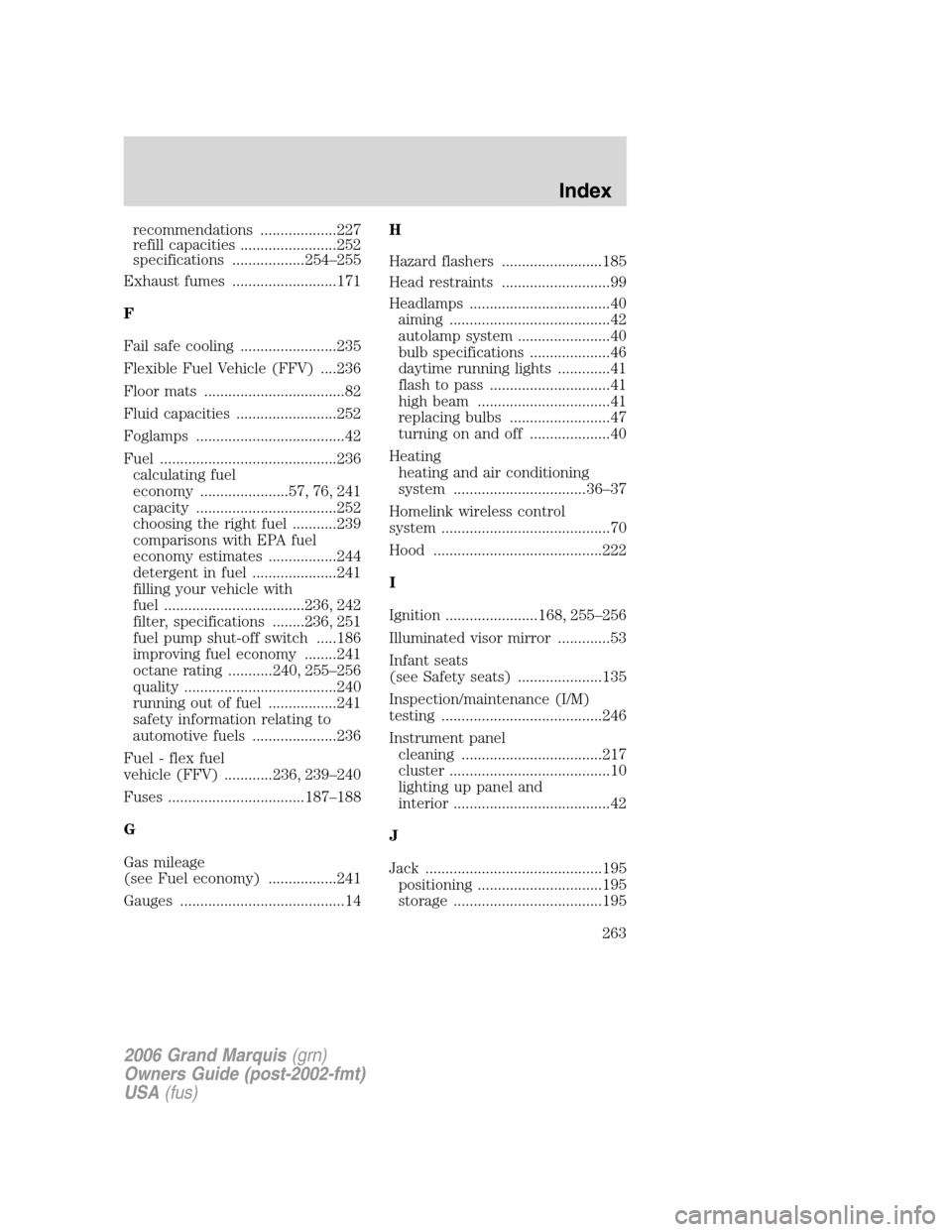
recommendations ...................227
refill capacities ........................252
specifications ..................254–255
Exhaust fumes ..........................171
F
Fail safe cooling ........................235
Flexible Fuel Vehicle (FFV) ....236
Floor mats ...................................82
Fluid capacities .........................252
Foglamps .....................................42
Fuel ............................................236
calculating fuel
economy ......................57, 76, 241
capacity ...................................252
choosing the right fuel ...........239
comparisons with EPA fuel
economy estimates .................244
detergent in fuel .....................241
filling your vehicle with
fuel ...................................236, 242
filter, specifications ........236, 251
fuel pump shut-off switch .....186
improving fuel economy ........241
octane rating ...........240, 255–256
quality ......................................240
running out of fuel .................241
safety information relating to
automotive fuels .....................236
Fuel - flex fuel
vehicle (FFV) ............236, 239–240
Fuses ..................................187–188
G
Gas mileage
(see Fuel economy) .................241
Gauges .........................................14H
Hazard flashers .........................185
Head restraints ...........................99
Headlamps ...................................40
aiming ........................................42
autolamp system .......................40
bulb specifications ....................46
daytime running lights .............41
flash to pass ..............................41
high beam .................................41
replacing bulbs .........................47
turning on and off ....................40
Heating
heating and air conditioning
system .................................36–37
Homelink wireless control
system ..........................................70
Hood ..........................................222
I
Ignition .......................168, 255–256
Illuminated visor mirror .............53
Infant seats
(see Safety seats) .....................135
Inspection/maintenance (I/M)
testing ........................................246
Instrument panel
cleaning ...................................217
cluster ........................................10
lighting up panel and
interior .......................................42
J
Jack ............................................195
positioning ...............................195
storage .....................................195
2006 Grand Marquis(grn)
Owners Guide (post-2002-fmt)
USA(fus)
Index
263